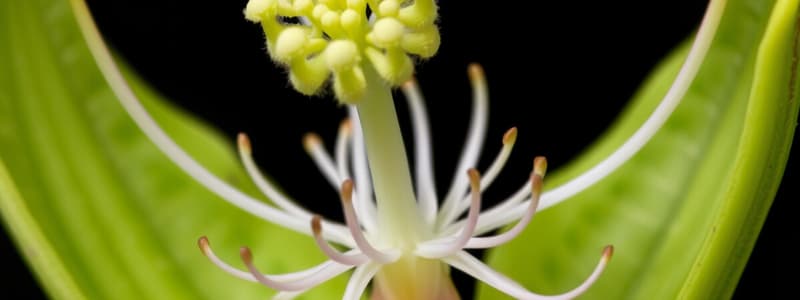Podcast
Questions and Answers
What is the primary function of prop roots in banyan trees?
What is the primary function of prop roots in banyan trees?
- To support the tree and provide stability (correct)
- To facilitate airborne respiration
- To store food for the plant
- To absorb water and minerals from the soil
Which type of root is primarily modified for the storage of food?
Which type of root is primarily modified for the storage of food?
- Adventitious roots
- Tap roots (correct)
- Pneumatophores
- Stilt roots
What distinguishes stems from roots?
What distinguishes stems from roots?
- Stems develop from the root system of a plant
- Stems bear leaves, flowers, and fruits (correct)
- Stems primarily function in water absorption
- Stems possess stilt roots for support
What kind of modification do pneumatophores provide for plants like Rhizophora?
What kind of modification do pneumatophores provide for plants like Rhizophora?
What is the primary function of stilt roots found in maize and sugarcane?
What is the primary function of stilt roots found in maize and sugarcane?
What was the primary method used for the description of diverse life forms on earth?
What was the primary method used for the description of diverse life forms on earth?
Why is the detailed description of morphological features considered significant?
Why is the detailed description of morphological features considered significant?
In which unit are the structural organizations of plants and animals described separately?
In which unit are the structural organizations of plants and animals described separately?
Flashcards are hidden until you start studying
Study Notes
Morphology and Anatomy Overview
- Description of diverse life forms based on structural features observed through magnifying tools.
- Focus on both external and internal structures, leading to historical naturalist methods.
- Morphological and anatomical features are crucial for understanding biological processes.
Modifications of Roots
- Roots in some plants adapt for support, food storage, and respiration beyond their primary role of water and mineral absorption.
- Examples of root adaptations include:
- Storage: Tap roots like carrot and turnip swell to store nutrients.
- Support: Prop roots of banyan trees and stilt roots of maize and sugarcane offer physical support.
- Respiration: Pneumatophores in Rhizophora facilitate gas exchange in swampy conditions.
The Stem
- Stems are the ascending part of a plant bearing branches, leaves, flowers, and fruits, developing from the embryo's plumule.
- Stems contain nodes (where leaves arise) and internodes (sections between nodes).
- Buds on stems can be terminal or axillary, contributing to photosynthesis.
- Modifications of stems can include:
- Storage: Underground stems (e.g., potato) store nutrients.
- Support: Tendrils (e.g., ginger) or spines provide protection.
- Propagation: Lateral branches in mint and jasmine can touch the ground to produce new plants.
The Leaf
- Leaves are generally flattened structures attached to stems and may develop into fruits without fertilization (parthenocarpic fruits).
- Fruits consist of pericarp layers: epicarp (outer), mesocarp (middle), and endocarp (inner).
- Example fruits include mango and coconut, classified as drupes, characterized by a distinct pericarp structure.
The Seed
- Seed development occurs post-fertilization of ovules, consisting of a seed coat and embryo.
- The structure of a dicotyledonous seed includes:
- Seed Coat: Composed of outer testa and inner tegmen, with the hilum as a scar point and micropyle as a pore.
- Embryo Components: Consists of an embryonal axis and two cotyledons; end with radicle (root) and plumule (shoot).
Vegetative and Floral Characters
- Vegetative Features: Plants can be categorized as trees, shrubs, or herbs; roots may have root nodules.
- Floral Features: Vary from inflorescence type to detailed flower anatomy (e.g., calyx, corolla, androecium, gynoecium).
- Example of a flowering plant structure includes pea (Pisum sativum):
- Inflorescence: Racemose, meaning flowers are arranged on a central stem.
- Flowers: Bisexual with unique petal arrangements and a specific fruit type (legume).
Economic Importance of Plant Families
- Certain families provide various economically important products:
- Legumes (Fabaceae): Sources of pulses, edible oils, and medicinal plants.
- Solanaceae (Potato family): Widely distributed, includes many important crops like potatoes and tomatoes.
Studying That Suits You
Use AI to generate personalized quizzes and flashcards to suit your learning preferences.



